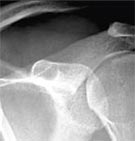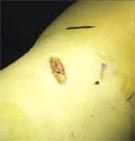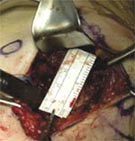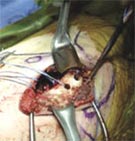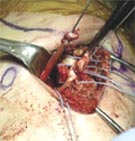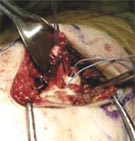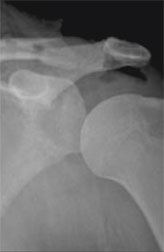Surgeons detail anatomic reconstruction of the coracoclavicular ligaments
Operative stabilization of acromioclavicular joint injuries is typically recommended for Rockwood type IV (posterior clavicular displacement, often through trapezius), type V (extreme superior elevation through the deltotrapezial fascia) and type VI (inferior displacement of the clavicle).
Treatment remains controversial for Allman/Tossey type III injuries (ie, disruption of the coracoclavicular ligaments and greater than 100% superior displacement of the clavicle), with some surgeons advocating early reconstruction and others recommending initial nonoperative management and later reconstruction if painful instability or unacceptable cosmetic results develop.
Many techniques have been described to restore alignment of the acromioclavicular joint. The most commonly used technique is the modified Weaver-Dunn procedure, in which the coracoacromial ligament is transferred into the distal end of the clavicle with suture, tape or screw augmentation. We have been concerned, however, that this is a nonanatomic repair, and clinical outcomes have varied. Therefore, we now prefer an anatomic reconstruction of the critically important coracoclavicular ligaments.
Urist showed that the coracoclavicular ligaments, specifically the conoid, are critical to prevent inferior displacement of the scapulohumeral complex. This technique focuses on anatomically reconstructing these ligaments and is modified from a technique originally described by Mazzocca et al.
|
|
|
|
|
|
|
|
Courtesy of John-Erik Bell |
Illustrative case
In this case, a type 5 coracoclavicular joint injury is shown on the AP radiograph (Fig. 1). We use combined regional and general anesthesia, and the patient is placed in the beach chair position using a pneumatic arm holder. The arm is prepped into the operative field.
The ipsilateral leg is also prepped for harvesting of the semitendinosus autograft. This is done by standard technique through a 2-cm incision (Fig. 2). The graft is controlled on both ends with running Krackow sutures.
Bony landmarks, including the clavicle, the acromion and the coracoid process, are drawn (Fig. 3). The incision is made in Langer’s lines starting at the posterior AC joint and ending just superior and medial to the coracoid process. Full thickness skin flaps are elevated, keeping the deltotrapezial fascia intact.
Raise sufficient flaps to allow access to the clavicle at least 5 cm medially from the AC joint and to the anterolateral tip of the acromion laterally. A fascial incision is made along the longitudinal midline of the clavicle directly to bone and is then extended laterally, sweeping gently anteriorly to the anterior edge of the acromion. The capsule of the AC joint is then incised and the intra-articular disc is excised.
Subperiosteally expose the distal 5 cm of the clavicle. Identify the subacromial bursal space and bluntly develop this space to the coracoid. It is important to adequately develop this space in order to pass the sutures and the graft, as there may be adhesions from the trauma of the injury.
|
We use a gallbladder clamp to pass around the coracoid process and then pass three #5 Fiberwire sutures (Arthrex Inc.) and a loop of #2 nonabsorbable sutures. Two of the #5 Fiberwires are used to “saw through” the residual soft tissue to ensure that the graft is in direct contact with the bone of the coracoid process, and to create a clear path for the graft. These two are then removed. The loop is left to facilitate passage of the graft, and the #5 Fiberwire is later used for additional suture augmentation of the reconstruction.
Next, we create tunnels at the attachment sites of the ruptured conoid and trapezoid ligaments. A cannulated reamer guide pin for the conoid tunnel is placed at its anatomic position 45 mm medial to the distal end of the clavicle in the posterior half of the clavicle (Fig. 4). The guide pin is also directed obliquely toward the coracoid to recreate the orientation of the native conoid ligament. The size of the tunnel will depend on the diameter of the graft (in the case shown, a 5.5-mm tunnel was made corresponding to a 5-mm graft).
It is important to make sure the posterior cortex is not breached by the reamer because it will make interference screw fixation impossible. This sequence is then repeated for creation of the trapezoid tunnel, which is placed centrally in the clavicle at its anatomic insertion 15 mm lateral to the conoid tunnel.
|
Suture shuttles (#2 nonabsorbable) are then placed in the tunnels, with the looped ends emerging from the inferior ends of the tunnels (Fig. 5). Next, pass the graft around the coracoid using the previously placed suture shuttle (Fig. 6). Pass the sutures from each end of the graft through their respective bone tunnels using the previously placed suture shuttles (Fig. 7).
The acromioclavicular joint is then reduced or slightly overreduced to allow for later creep and the introduction of gravity. It is important to realize that the clavicle is not displaced superiorly as much as the scapula and shoulder girdle are displaced inferiorly. Therefore, the reduction maneuver involves lifting up on the arm and reducing the acromion to the clavicle. Simply pushing down on the clavicle may not yield a full reduction.
We perform nonbiologic fixation for the reduction when the augmentation #5 Fiberwire suture previously placed around the clavicle is brought through both bone tunnels and secured. The graft is then tensioned and secured with appropriately sized bioabsorbable interference screws (Figs. 8 and 9). We use the Biotenodesis screw system by Arthrex.
The deltoid is repaired via bone tunnels in the anterior acromion and the delto-trapezial fascia is anatomically repaired with nonabsorbable sutures. The skin is then closed in layers. AP or Zanca radiographs are taken immediately postoperatively for comparison at the six-week follow-up appointment (Fig. 10).
The patient is placed in a sling postoperatively and no motion is a llowed for the first four weeks. Formal physical therapy and home exercises typically start at four weeks. The sling is discontinued at six weeks postoperatively. Isometrics are initiated between 12-24 weeks, and contact athletics are allowed at six months.
John-Erik Bell, MD, and William N. Levine, MD, are orthopedic surgeons at the Center for Shoulder, Elbow and Sports Medicine at Columbia University Medical Center, New York. Augustus D. Mazzocca, MD, is in the department of orthopedic surgery at the University of Connecticut Health Center in Farmington.
For more information:
- Fukuda K, Craig EV, Kai-Nan A, et al. Biomechanical study of the ligamentous system of the acromioclavicular joint. J Bone Joint Surg. 1986;68:434-439,.
- Mazzocca AD, Conway JE, Johnson S, et al. The anatomic coracoclavicular ligament reconstruction. Operative Techniques in Sports Medicine. 2004;12:56-61.
- Urist MR. Complete dislocations of the acromioclavicular joint. The nature of the traumatic lesion and effective methods of treatment with an analysis of forty-one cases. J Bone Joint Surg. 28:813-837.

